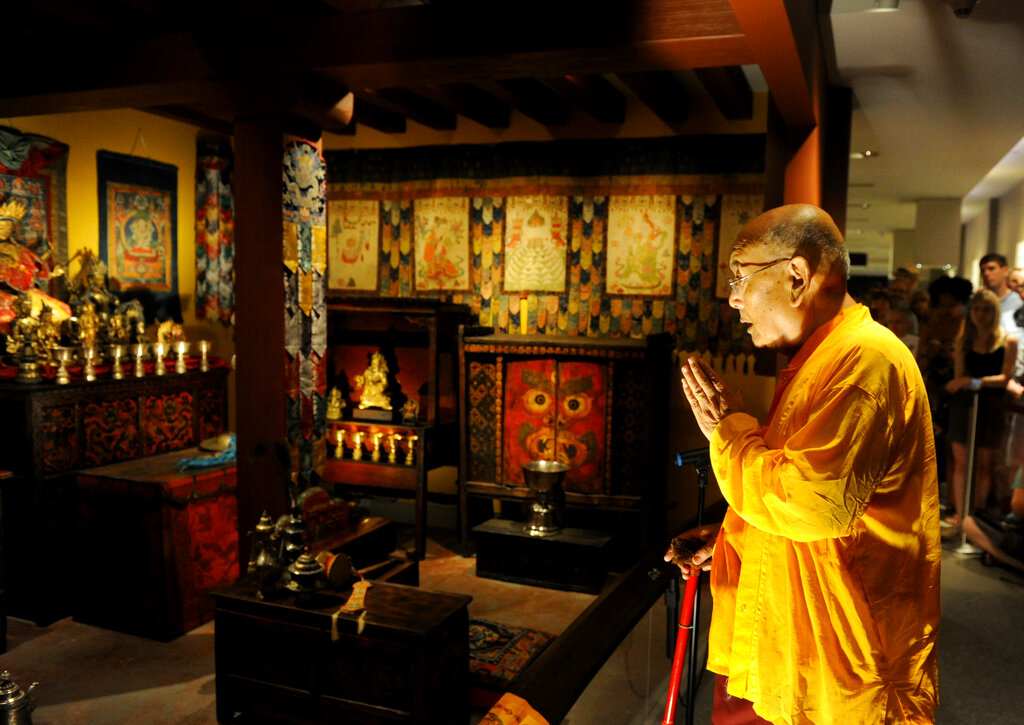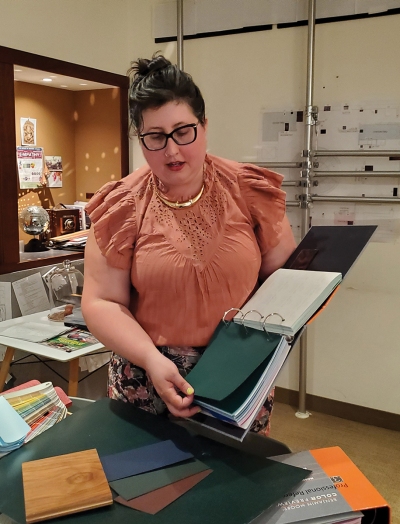 The Tibestan lama Bardok Chusang Rinpoche blessing the Tibetan Shrine Room at the Rubin Museum of Art, New York, 2013. Photo Diane Bondareff/Invision for the Rubin Museum of Art/AP Images
The Tibestan lama Bardok Chusang Rinpoche blessing the Tibetan Shrine Room at the Rubin Museum of Art, New York, 2013. Photo Diane Bondareff/Invision for the Rubin Museum of Art/AP Images
Q&A with Brianne Muscente-Solga, senior manager of exhibition design at the Rubin Museum of Art, New York.
What does your role entail?
I am responsible for helping conceive and execute the designs for on-site installations and exhibitions from start to finish, across the curatorial, visitor experience, collections, graphics, conservation, and operations departments. I also coordinate and schedule installations for the museum staff. Through design, I ensure that visitors have a positive experience with the look and feel of our galleries.
Walk me through the design process behind the new Mandala Lab.
The idea of the Mandala Lab started in 2019. The facility, which will be a permanent installation on our third floor, was inspired by the Tibetan Buddhist mandalas from the museum’s collection. We wanted to create an interactive experience that is educational but also self-reflexive. To do this, we enlisted the help of Miriam Peterson and Nathan Rich from the design studio Peterson Rich Office.
The Mandala Lab has both analog and digital components to keep a range of visitors engaged. This is something I think about a lot when I’m working because I wouldn’t want to limit anyone’s experience. And, since this is an educational tool, we really had to consider different methods of social, emotional, and ethical learning. The floor is broken down into five sections in additional to a central hub, somewhat akin to different parts of a mandala. These areas accommodate breathing exercises timed to the pulse of a light; a scent library; a space for people to write; a gong for people to hit, which then lowers into water to create a ripple effect; and a place for mantra teaching.
The concept is that this journey, while it is individual, brings visitors closer to the collective. Throughout, there are multiple opportunities to connect through experience. It’s a space people can continue to come back to. And the Rubin really strives to provide visitors with tools and teachings they can use in the outside world. Now, after the long lockdown, it feels especially important that people have a space where they can reflect and connect.
 Portrait of Brianne Muscente-Solga, 2021. Courtesy the Rubin Museum of Art, New York
Portrait of Brianne Muscente-Solga, 2021. Courtesy the Rubin Museum of Art, New York
How has Covid-19 impacted your work?
The installation teams have been on-site sporadically to work in the galleries since August of 2020. First, they were prepping the museum. We had to strip a lot out to make it ready for the public. Now, we have to get people back in and excited. It was an incredible challenge to install the design during the pandemic.
Staff members who worked remotely were very fortunate already to have many communication and project management tools, such as Slack and Asana, to help carry out our plans. Thankfully, our people have been pretty extraordinary about keeping things moving forward.
What are some tricks of the trade?
I tell all my junior designers that flexibility is their greatest asset and to anticipate the unexpected. You might feel like you’re putting all the right things on the page, and yet when you bring it to a stakeholder or curator, they might not see the same thing you do. You have to be able to listen to their critique and build on it. We’re essentially translating what is in someone’s mind and putting it into an actual space. And not everybody you work with can visualize what that is going to look like, even after seeing models and renderings.
I’m very encouraged and inspired by the influx of creative young minds. It is still a very male-dominated industry, but it is really diversifying. I feel very fortunate to be in my position and to have the support of the institution.
Have you come across anything particularly notable in your career?
When I was working on the [2015–16] exhibition “Superheroes of Gotham” at the New-York Historical Society, I met the collector who owns the Batmobile and the Munster car. We went out to his home, and I got to sit in the Batmobile. One of the coolest things about working in a museum is experiencing the collection and the loans.
Source link : https://www.artnews.com/art-in-america/interviews/exhibition-designer-brianne-muscente-solga-on-connecting-and-healing-through-art-1234604854












